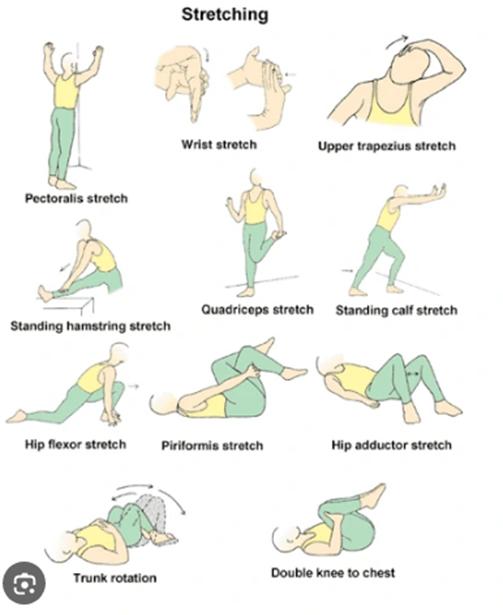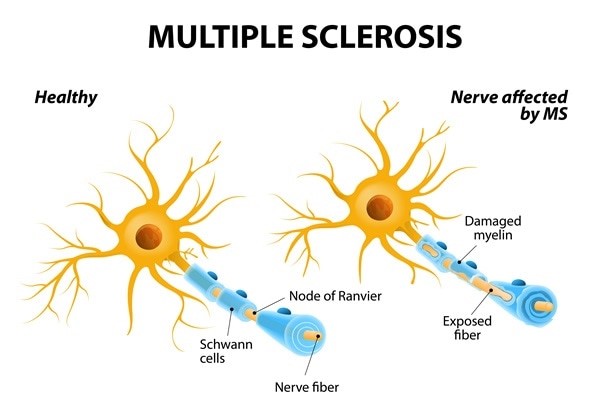The nurse is creating an education plan for a client who has a recent diagnosis of Multiple Sclerosis (MS). Which of the following interventions should the nurse include in the client's plan?
Provide total assistance with all ADLs
Order a low-residue diet
Encourage client to void every hour
Instruct the client on daily muscle stretching
The Correct Answer is D
Choice A reason: Providing total assistance with all ADLs is not an intervention that should be included in the client's plan. ADLs are activities of daily living, such as bathing, dressing, eating, and toileting. Providing total assistance with all ADLs can reduce the client's independence and self-esteem, and increase their dependence and learned helplessness. The nurse should encourage and assist the client to perform as much as they can by themselves and provide partial or intermittent assistance only when needed.
Choice B reason: Ordering a low-residue diet is not an intervention that should be included in the client's plan. A low-residue diet is a type of diet that limits foods that are high in fiber or indigestible material, such as whole grains, nuts, seeds, fruits, and vegetables. A low-residue diet may be recommended for clients who have inflammatory bowel disease (IBD), diverticulitis, or bowel obstruction, as it can reduce bowel frequency and irritation. However, it is not indicated for clients who have MS, unless they have other comorbidities that require it. A balanced diet that includes adequate fiber, fluids, and nutrients is more beneficial for clients who have MS.
Choice C reason: Encouraging the client to void every hour is not an intervention that should be included in the client's plan. Voiding every hour can be inconvenient and impractical for the client, and may not address their bladder problems effectively. MS can cause bladder dysfunction, such as urinary urgency, frequency, incontinence, or retention, due to nerve damage that affects bladder control. The nurse should assess the type and severity of the bladder dysfunction, and provide appropriate interventions, such as medication, catheterization, pelvic floor exercises, or bladder training.
Choice D reason: Instructing the client on daily muscle stretching is an intervention that should be included in the client's plan. Muscle stretching is a type of exercise that involves extending or elongating a muscle or group of muscles to their full length. Muscle stretching can help prevent or relieve muscle spasticity, stiffness, pain, or contractures that may occur in clients who have MS. The nurse should teach the client how to perform muscle stretching safely and correctly, and encourage them to do it daily or as prescribed.

Nursing Test Bank
Naxlex Comprehensive Predictor Exams
Related Questions
Correct Answer is A
Explanation
Choice A reason: It is a tool that is used to determine your maximum level of self-sufficiency as the appropriate nursing response, as it accurately describes the purpose and function of the FIM. The FIM measures how much assistance you need to perform 18 activities of daily living, such as eating, dressing, toileting, walking, and communicating. The FIM helps to evaluate your functional status, monitor your progress, and plan your rehabilitation goals and interventions. ¹²³
Choice B reason: It is a test that determines which activities you feel most comfortable performing is not an appropriate nursing response, as it does not reflect the objective and standardized nature of the FIM. The FIM is not a subjective or self-reported measure of your preferences or comfort level, but rather an observational and rating scale that assesses your actual performance and independence in various tasks. The FIM uses a 7-point ordinal scale that ranges from 1 (total assistance) to 7 (complete independence) and requires trained and certified raters to administer and score it. ¹²³
Choice C reason: It is a tool used by insurance companies to determine qualifications for medical reimbursement is not an appropriate nursing response, as it does not capture the primary purpose and benefit of the FIM. The FIM is not a financial or administrative tool that determines your eligibility or coverage for medical services, but rather a clinical and research tool that measures your functional outcomes and quality of care. The FIM provides a uniform system of measurement for disability based on the International Classification of Impairment, Disabilities, and Handicaps and allows for comparison and evaluation of different rehabilitation programs and settings. ¹²³
Choice D reason: It is a tool that is used to assess what services you will need a home health aide to perform for you is not an appropriate nursing response, as it does not reflect the comprehensive and multidimensional scope of the FIM. The FIM is not a specific or limited tool that assesses only your home care needs or dependence on others, but rather a general and broad tool that assesses your functional abilities and disabilities in various domains and environments. The FIM covers both motor and cognitive aspects of functioning, such as comprehension, expression, social interaction, problem-solving, and memory. The FIM can be used with all diagnoses within rehabilitation and can be applied across different levels and settings of care.
Correct Answer is ["B","C"]
Explanation
Choice A reason: "I may experience urinary incontinence." This statement does not indicate the need for additional teaching. It is a correct statement that reflects an understanding of one of the possible symptoms of MS. Urinary incontinence is caused by nerve damage that affects bladder control.
Choice B reason: "I should not exercise because this may trigger an exacerbation." This statement indicates the need for additional teaching. It is an incorrect statement that reflects a misconception about exercise and MS. Exercise does not cause or worsen MS relapses but rather has many benefits for people with MS, such as improving muscle strength, balance, mobility, mood, and quality of life.
Choice C reason: "I should alternate the eye patch every other day to help with the double vision." This statement indicates the need for additional teaching. It is an incorrect statement that reflects a misunderstanding of how to manage double vision, which is another possible symptom of MS. Alternating the eye patch every other day does not help with double vision, but rather may cause eye fatigue or confusion. The correct way to use an eye patch is to wear it on one eye only when needed, such as when reading or driving.
Choice D reason: "I may experience visual disturbances." This statement does not indicate the need for additional teaching. It is a correct statement that reflects an awareness of another possible symptom of MS. Visual disturbances may include blurred vision, loss of color vision, pain in one eye, or partial or complete blindness.
Choice E reason: "I need to check the water temperature before I take a bath." This statement does not indicate the need for additional teaching. It is a correct statement that reflects a precaution that people with MS should take. Checking the water temperature before taking a bath can prevent burns or scalds, as some people with MS may have reduced sensation or numbness in their skin.

Whether you are a student looking to ace your exams or a practicing nurse seeking to enhance your expertise , our nursing education contents will empower you with the confidence and competence to make a difference in the lives of patients and become a respected leader in the healthcare field.
Visit Naxlex, invest in your future and unlock endless possibilities with our unparalleled nursing education contents today
Report Wrong Answer on the Current Question
Do you disagree with the answer? If yes, what is your expected answer? Explain.
Kindly be descriptive with the issue you are facing.
